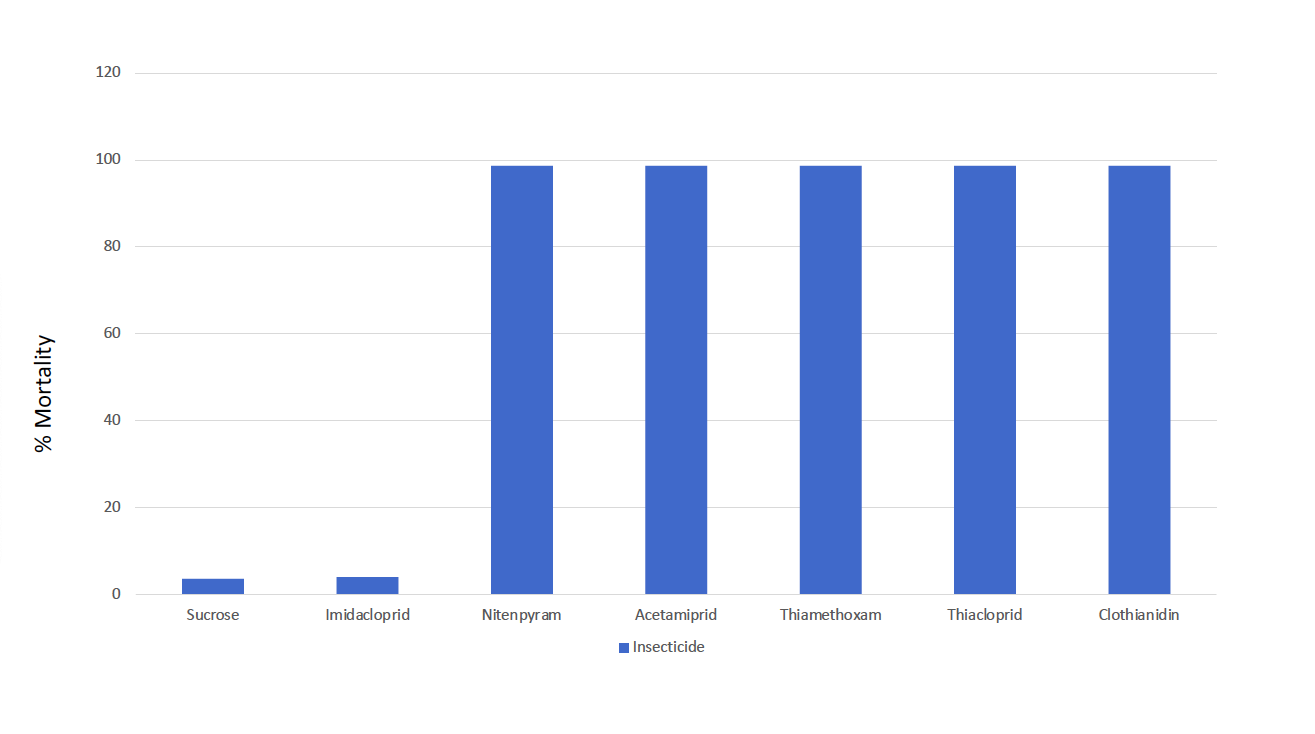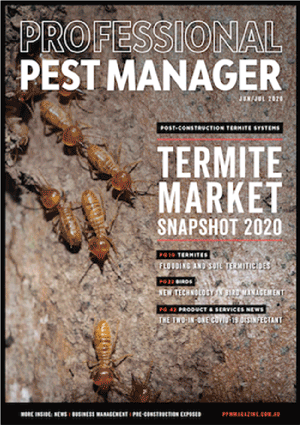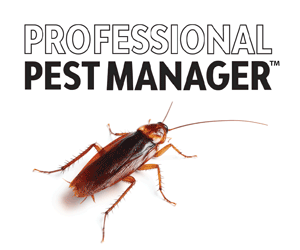Houseflies are known to have some level of resistance to insecticides but their resistance to neonicotinoids has only now been fully explored.
Insecticide resistance is common in houseflies, particularly to pyrethroids. As with most cases of insecticide resistance, pyrethroid resistance developed through overuse of pyrethroid sprays. With houseflies, this occurred in animal husbandry facilities, where houseflies are a particular problem in chicken farms and piggeries. However, shortly after the use of imidacloprid baits became commonplace, reports of resistance in the field began to appear.
Having now been on the market for over 20 years, there is increasing evidence of both physiological and behavioural resistance to imidacloprid in housefly populations, especially in areas of high insecticide use.
Physiological resistance is when genetic mutations increase the tolerance to an insecticide and when the occurrence of this mutation increases in a population, resistant populations develop. Commonly, physiological resistance to an insecticide also confers cross-resistance to other insecticides in the same insecticide group. Houseflies resistant to imidacloprid show increased resistance to other neonicotinoids.

Behavioural resistance can be defined as “those actions, evolved in response to the selective pressures exerted by a toxicant, that enhance the ability of a population to avoid the lethal effects of that toxicant”.1 A number of cases of behavioural resistance in houseflies have been documented. In one study, flies exhibited high behavioural resistance to imidacloprid, with mortality rates never exceeding 28%, even at the highest concentrations.2 Another study showed that flies rarely visit or feed on baits containing imidacloprid.3
The question is, do flies demonstrating behavioural resistance to imidacloprid also show behavioural resistance to other neonicotinoids?
A team of researchers from the University of California, Riverside, decided to investigate whether flies that were resistant to imidacloprid would show behavioural crossresistance i.e. resistance to other neonicotinoids. Their findings were published in the Journal of Medical Entomology in August 2024.4
To test for possible behavioural cross-resistance, the research team carried out a series of choice and no-choice trials. They devised an experiment that involved taking 75 flies and dividing them between three chambers. The first chamber contained a cup of insecticide-treated sucrose; the second chamber contained a cup of normal sucrose and a cup of insecticide-treated sucrose; and the third chamber was a control (just a cup of sucrose). This means the flies in the first chamber had just no choice (take or leave the insecticide-treated sucrose) while in the second chamber they were free to choose between plain sucrose or the sucrose containing insecticide. The experiment was repeated using the neonic insecticides acetamiprid, clothianidin, imidacloprid, nitenpyram, thiacloprid, and thiamethoxam. The mortality rate of the flies was recorded after 72 hours.
In the no-choice tests (first chamber), all of the insecticides including imidacloprid achieved mortality at nearly or equal to 100%. In the choice tests (second chamber), high mortality was seen for acetamiprid, thiamethoxam, clothianidin, nitenpyram, and thiacloprid, at 98.7%. When flies were exposed imidacloprid, mortality was a very low 4%. The results show flies are physiologically susceptible to all the insecticides tested, but the flies only showed behavioural resistance to imidacloprid.

Although detailing the mechanism of behavioural resistance in houseflies has been challenging, this trial with the BRS-1 strain of housefly would suggest that this behavioural resistance is based on the detection of imidacloprid itself i.e. the houseflies can detect the presence of imidacloprid and when given the choice they avoid feeding on food containing imidacloprid. Further, there are structural differences between the imidacloprid molecule and other neonicotinoid insecticides, which could explain why they can specifically detect imidacloprid and do not generalise the response to all neonicotinoids. However, this needs to be investigated further.
Interestingly, a further study indicated that whilst physiological resistance in houseflies is unstable – it can disappear from a population when the insecticide pressure is removed – behavioural resistance appears to be quite stable in the population.5 This means that while rotation of insecticides with a different mode of action may allow the use of imidacloprid in the future on populations showing physiological resistance to imidacloprid, insecticide rotation may not eliminate behavioural resistance to imidacloprid from the population.
Pest managers should be aware of the potential for imidacloprid resistance in houseflies, although this is more likely to occur in accounts with high insecticide use. Preventing this from occurring in the first place can be achieved through good resistance management and rotating through insecticides with different modes of action. If imidacloprid resistance is suspected in a population, other neonicotinoids may still prove to be effective if resistance is behaviour-based. However, rotation to a different class of insecticide would still be the smart call, to avoid the potential development of physiological resistance.
References
1 Caleb B Hubbard, Amy C Murillo. Behavioral resistance to insecticides: current understanding, challenges, and future directions. Current Opinion in Insect Science, Vol 63, 2024, 101177, ISSN 2214-5745. https://doi.org/10.1016/j.cois.2024.101177
2 Gerry, Alec & Zhang, Diane. (2009). Behavioral resistance of house flies, Musca domestica (Diptera: Muscidae) to imidacloprid. U.S. Army Medical Department journal. 54-9.
3 Mullens, Bradley & Gerry, Alec & Diniz, Alesha. (2010). Field and Laboratory Trials of a Novel Metaflumizone House Fly (Diptera: Muscidae) Bait in California. Journal of Economic Entomology. 103. 550-6. 10.1603/EC09293.
4 Jaqueline N Torres, et al. Examining imidacloprid behaviorally resistant house flies (Musca domestica L.) (Diptera: Muscidae) for neonicotinoid cross-resistance. Journal of Medical Entomology, Vol 61, Issue 6, Nov 2024, pp 1443–1447. https://doi. org/10.1093/jme/tjae105
5 Murillo, A.C et al. (2024). Evaluation of the stability of physiological and behavioral resistance to imidacloprid in the house fly (Musca domestica L.) (Diptera: Muscidae). Pest Manag Sci. 80(3):1361-1366. DOI: 10.1002/ps.7866
‘House Fly Resistance to One Neonic Insecticide Doesn’t Extend to Others, Study Shows’, by Andrew Porterfield. September 24, 2024, Entomology Today.


